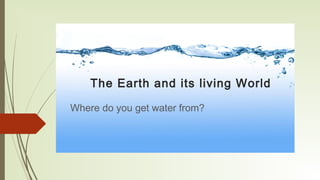The earth and its living world
•Transferir como PPT, PDF•
6 gostaram•6,993 visualizações
For class 5 (Maharashtra Board)
Denunciar
Compartilhar
Denunciar
Compartilhar

Recomendados
Recomendados
Mais conteúdo relacionado
Mais procurados
Mais procurados (20)
Grade 6 geography chapter 1 Earth in the solar system

Grade 6 geography chapter 1 Earth in the solar system
CLASS 7: Weather, climate and adaptations of animals to climate 

CLASS 7: Weather, climate and adaptations of animals to climate
Destaque (20)
Semelhante a The earth and its living world
Semelhante a The earth and its living world (20)
Mais de Jnana Prabodhini Educational Resource Center
Mais de Jnana Prabodhini Educational Resource Center (20)
Último
https://app.box.com/s/7hlvjxjalkrik7fb082xx3jk7xd7liz3TỔNG ÔN TẬP THI VÀO LỚP 10 MÔN TIẾNG ANH NĂM HỌC 2023 - 2024 CÓ ĐÁP ÁN (NGỮ Â...

TỔNG ÔN TẬP THI VÀO LỚP 10 MÔN TIẾNG ANH NĂM HỌC 2023 - 2024 CÓ ĐÁP ÁN (NGỮ Â...Nguyen Thanh Tu Collection
Último (20)
Micro-Scholarship, What it is, How can it help me.pdf

Micro-Scholarship, What it is, How can it help me.pdf
Interdisciplinary_Insights_Data_Collection_Methods.pptx

Interdisciplinary_Insights_Data_Collection_Methods.pptx
Exploring_the_Narrative_Style_of_Amitav_Ghoshs_Gun_Island.pptx

Exploring_the_Narrative_Style_of_Amitav_Ghoshs_Gun_Island.pptx
Beyond_Borders_Understanding_Anime_and_Manga_Fandom_A_Comprehensive_Audience_...

Beyond_Borders_Understanding_Anime_and_Manga_Fandom_A_Comprehensive_Audience_...
This PowerPoint helps students to consider the concept of infinity.

This PowerPoint helps students to consider the concept of infinity.
Sensory_Experience_and_Emotional_Resonance_in_Gabriel_Okaras_The_Piano_and_Th...

Sensory_Experience_and_Emotional_Resonance_in_Gabriel_Okaras_The_Piano_and_Th...
NO1 Top Black Magic Specialist In Lahore Black magic In Pakistan Kala Ilam Ex...

NO1 Top Black Magic Specialist In Lahore Black magic In Pakistan Kala Ilam Ex...
TỔNG ÔN TẬP THI VÀO LỚP 10 MÔN TIẾNG ANH NĂM HỌC 2023 - 2024 CÓ ĐÁP ÁN (NGỮ Â...

TỔNG ÔN TẬP THI VÀO LỚP 10 MÔN TIẾNG ANH NĂM HỌC 2023 - 2024 CÓ ĐÁP ÁN (NGỮ Â...
Unit 3 Emotional Intelligence and Spiritual Intelligence.pdf

Unit 3 Emotional Intelligence and Spiritual Intelligence.pdf
The earth and its living world
- 1. The Earth and its living World Where do you get water from?
- 2. On the surface of the earth, there is some land and water Spheres of the Earth Lithosphere - Land Hydrosphere - Water Atmosphere - Air constituents Biosphere - Living things.
- 3. Lithosphere Earth's crust is hard rock and soil Lanol - grassy;sand,crops,forests 1/3 part of lithosphere- Land
- 4. Continent Large or Vast continuous stretch of Land. Divided into seven continents Africa, Asia, Europe, North America, South America Australia, Antarctica
- 5. Land forms Land is not even in all places Give rise to different shapes eg. Plain, Hill, Mountain
- 6. Hydrosphere 2/3 part of earth covered with water. Water part is divided into : Ocean- salty water, Surface water and fresh water
- 7. Oceans Salty water - five oceans Atlantic, Pacific, Arctic, South Ocean, Indian Ocean. Land along margins of ocean called coastal region Water bodies of different shapes and sizes.- sea, bay, strait, Gulf etc.
- 8. Rivers Fresh water reservoirs streams of water flowing over the land Streams are - Rills, Brook, Rivers Rills, brooks, streams - join to form rivers Rivers join to make bigger river tributaries Rivers cascade down a sudden drop - water fall Rivers flow to the ocean.
- 9. Lakes Water collected in a low lying area of land - Lakes eg. Manas sarowar
- 10. Ice form of water, Glacier water particles in the clouds freeze in cold regions come down in the form of snow Layer of snow pile up on ground to form ice. In low - lying area ice pile become huge mass slips down; a slope - glacier Blocks of ice floting in sea- Iceberg
- 11. Groundwater- (Well) water stored in underground layer well, bore wells, under ground springs Hydro Sphere :water on earth is surface, Ground water, Water vapours
- 12. Atmosphere Air around Earth Higher from the surface air becomes rarer. Consists- mixture of gases, nitrogen, oxygen, water vapour, carbon dioxide Layers of Atmosphere Troposphere, Stratosphere, Mesosphere Ionosphere, Exosphere
- 13. Troposphere 13 km from earth's surface conditions changes continuously Go higher in troposphere air becomes cooler Weather related phenomena rain, fog, clouds, Winds, Storms. Aeroplanes fly in higher parts (mountaineers)
- 14. Stratosphere Beyond troposphere about 50 km Ozone gas layer Ozon layer absorbs ultra violet rays.
- 15. How does it rain
- 16. Water evaporates due to sun's heat Water vapour lighter than air, Goes higer,cools,condenses- Fine drop lets of water Droplets forms clouds. Smaller droplets Bigger drop can not float Fall down on the earth- Rain
- 17. Water Cycle Rain water flows into rills, streams, rivers and finally into sea Evaporation of this water Condensation, rainfall continuously processes are done
- 18. Biosphere Variety of living things in different regions. Snowbound polar-bear , Africa –Zebras, Australia-Kangaroos, Hot climate- Elephants, Lions. Living things exist in litho, hydro, atmo Living world- biosphere
- 19. Plants, animals, microbes are dependent on one another Biosphere is where living things take birth, live and die
- 20. Three Layer of Earth Earth is surface occupied by land 1/3 and water 2/3 Litho - soil, rock Hydro - Salty, fresh water reservoir Atom –Tropo, strato Bio - All living things
